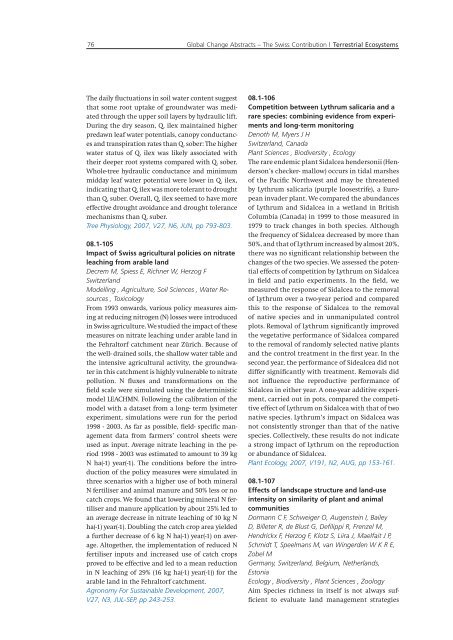Global Change Abstracts The Swiss Contribution - SCNAT
Global Change Abstracts The Swiss Contribution - SCNAT
Global Change Abstracts The Swiss Contribution - SCNAT
Create successful ePaper yourself
Turn your PDF publications into a flip-book with our unique Google optimized e-Paper software.
76<br />
<strong>The</strong> daily fluctuations in soil water content suggest<br />
that some root uptake of groundwater was mediated<br />
through the upper soil layers by hydraulic lift.<br />
During the dry season, Q. ilex maintained higher<br />
predawn leaf water potentials, canopy conductances<br />
and transpiration rates than Q. sober: <strong>The</strong> higher<br />
water status of Q. ilex was likely associated with<br />
their deeper root systems compared with Q. sober.<br />
Whole-tree hydraulic conductance and minimum<br />
midday leaf water potential were lower in Q. ilex,<br />
indicating that Q. ilex was more tolerant to drought<br />
than Q. suber. Overall, Q. ilex seemed to have more<br />
effective drought avoidance and drought tolerance<br />
mechanisms than Q. suber.<br />
Tree Physiology, 2007, V27, N6, JUN, pp 793-803.<br />
08.1-105<br />
Impact of <strong>Swiss</strong> agricultural policies on nitrate<br />
leaching from arable land<br />
Decrem M, Spiess E, Richner W, Herzog F<br />
Switzerland<br />
Modelling , Agriculture, Soil Sciences , Water Resources<br />
, Toxicology<br />
From 1993 onwards, various policy measures aiming<br />
at reducing nitrogen (N) losses were introduced<br />
in <strong>Swiss</strong> agriculture. We studied the impact of these<br />
measures on nitrate leaching under arable land in<br />
the Fehraltorf catchment near Zürich. Because of<br />
the well- drained soils, the shallow water table and<br />
the intensive agricultural activity, the groundwater<br />
in this catchment is highly vulnerable to nitrate<br />
pollution. N fluxes and transformations on the<br />
field scale were simulated using the deterministic<br />
model LEACHMN. Following the calibration of the<br />
model with a dataset from a long- term lysimeter<br />
experiment, simulations were run for the period<br />
1998 - 2003. As far as possible, field- specific management<br />
data from farmers’ control sheets were<br />
used as input. Average nitrate leaching in the period<br />
1998 - 2003 was estimated to amount to 39 kg<br />
N ha(-1) year(-1). <strong>The</strong> conditions before the introduction<br />
of the policy measures were simulated in<br />
three scenarios with a higher use of both mineral<br />
N fertiliser and animal manure and 50% less or no<br />
catch crops. We found that lowering mineral N fertiliser<br />
and manure application by about 25% led to<br />
an average decrease in nitrate leaching of 10 kg N<br />
ha(-1) year(-1). Doubling the catch crop area yielded<br />
a further decrease of 6 kg N ha(-1) year(-1) on average.<br />
Altogether, the implementation of reduced N<br />
fertiliser inputs and increased use of catch crops<br />
proved to be effective and led to a mean reduction<br />
in N leaching of 29% (16 kg ha(-1) year(-1)) for the<br />
arable land in the Fehraltorf catchment.<br />
Agronomy For Sustainable Development, 2007,<br />
V27, N3, JUL-SEP, pp 243-253.<br />
<strong>Global</strong> <strong>Change</strong> <strong>Abstracts</strong> – <strong>The</strong> <strong>Swiss</strong> <strong>Contribution</strong> | Terrestrial Ecosystems<br />
08.1-106<br />
Competition between Lythrum salicaria and a<br />
rare species: combining evidence from experiments<br />
and long-term monitoring<br />
Denoth M, Myers J H<br />
Switzerland, Canada<br />
Plant Sciences , Biodiversity , Ecology<br />
<strong>The</strong> rare endemic plant Sidalcea hendersonii (Henderson’s<br />
checker- mallow) occurs in tidal marshes<br />
of the Pacific Northwest and may be threatened<br />
by Lythrum salicaria (purple loosestrife), a European<br />
invader plant. We compared the abundances<br />
of Lythrum and Sidalcea in a wetland in British<br />
Columbia (Canada) in 1999 to those measured in<br />
1979 to track changes in both species. Although<br />
the frequency of Sidalcea decreased by more than<br />
50%, and that of Lythrum increased by almost 20%,<br />
there was no significant relationship between the<br />
changes of the two species. We assessed the potential<br />
effects of competition by Lythrum on Sidalcea<br />
in field and patio experiments. In the field, we<br />
measured the response of Sidalcea to the removal<br />
of Lythrum over a two-year period and compared<br />
this to the response of Sidalcea to the removal<br />
of native species and in unmanipulated control<br />
plots. Removal of Lythrum significantly improved<br />
the vegetative performance of Sidalcea compared<br />
to the removal of randomly selected native plants<br />
and the control treatment in the first year. In the<br />
second year, the performance of Sidealcea did not<br />
differ significantly with treatment. Removals did<br />
not influence the reproductive performance of<br />
Sidalcea in either year. A one-year additive experiment,<br />
carried out in pots, compared the competitive<br />
effect of Lythrum on Sidalcea with that of two<br />
native species. Lythrum’s impact on Sidalcea was<br />
not consistently stronger than that of the native<br />
species. Collectively, these results do not indicate<br />
a strong impact of Lythrum on the reproduction<br />
or abundance of Sidalcea.<br />
Plant Ecology, 2007, V191, N2, AUG, pp 153-161.<br />
08.1-107<br />
Effects of landscape structure and land-use<br />
intensity on similarity of plant and animal<br />
communities<br />
Dormann C F, Schweiger O, Augenstein I, Bailey<br />
D, Billeter R, de Blust G, Defilippi R, Frenzel M,<br />
Hendrickx F, Herzog F, Klotz S, Liira J, Maelfait J P,<br />
Schmidt T, Speelmans M, van Wingerden W K R E,<br />
Zobel M<br />
Germany, Switzerland, Belgium, Netherlands,<br />
Estonia<br />
Ecology , Biodiversity , Plant Sciences , Zoology<br />
Aim Species richness in itself is not always sufficient<br />
to evaluate land management strategies

















